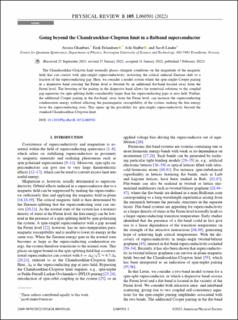| dc.contributor.author | Ghanbari Birgani, Atousa | |
| dc.contributor.author | Erlandsen, Eirik | |
| dc.contributor.author | Sudbø, Asle | |
| dc.contributor.author | Linder, Jacob | |
| dc.date.accessioned | 2023-02-08T11:25:49Z | |
| dc.date.available | 2023-02-08T11:25:49Z | |
| dc.date.created | 2022-02-08T07:15:13Z | |
| dc.date.issued | 2022 | |
| dc.identifier.citation | Physical review B (PRB). 2022, 105 (6), . | en_US |
| dc.identifier.issn | 2469-9950 | |
| dc.identifier.uri | https://hdl.handle.net/11250/3049224 | |
| dc.description.abstract | The Chandrasekhar-Clogston limit normally places stringent conditions on the magnitude of the magnetic field that can coexist with spin-singlet superconductivity, restricting the critical induced Zeeman shift to a fraction of the superconducting gap. Here, we consider a model system where the spin-singlet Cooper pairing in a dispersive band crossing the Fermi level is boosted by an additional flat-band located away from the Fermi level. The boosting of the pairing in the dispersive band allows for nontrivial solutions to the coupled gap equations for spin-splitting fields considerably larger than the superconducting gaps at zero field. Further, the additional Cooper pairing in the flat-band, away from the Fermi level, can increase the superconducting condensation energy without affecting the paramagnetic susceptibility of the system, making the free energy favor the superconducting state. This opens up the possibility for spin-singlet superconductivity beyond the standard Chandrasekhar-Clogston limit. | en_US |
| dc.description.abstract | Going beyond the Chandrasekhar-Clogston limit in a flatband superconductor | en_US |
| dc.language.iso | eng | en_US |
| dc.publisher | American Physical Society | en_US |
| dc.relation.uri | https://journals.aps.org/prb/abstract/10.1103/PhysRevB.105.L060501 | |
| dc.title | Going beyond the Chandrasekhar-Clogston limit in a flatband superconductor | en_US |
| dc.title.alternative | Going beyond the Chandrasekhar-Clogston limit in a flatband superconductor | en_US |
| dc.type | Peer reviewed | en_US |
| dc.type | Journal article | en_US |
| dc.description.version | publishedVersion | en_US |
| dc.rights.holder | ©2022 American Physical Society | en_US |
| dc.source.pagenumber | 6 | en_US |
| dc.source.volume | 105 | en_US |
| dc.source.journal | Physical review B (PRB) | en_US |
| dc.source.issue | 6 | en_US |
| dc.identifier.doi | 10.1103/PhysRevB.105.L060501 | |
| dc.identifier.cristin | 1998837 | |
| dc.relation.project | Norges forskningsråd: 323766 | en_US |
| dc.relation.project | Norges forskningsråd: 262633 | en_US |
| cristin.ispublished | true | |
| cristin.fulltext | postprint | |
| cristin.qualitycode | 2 | |
